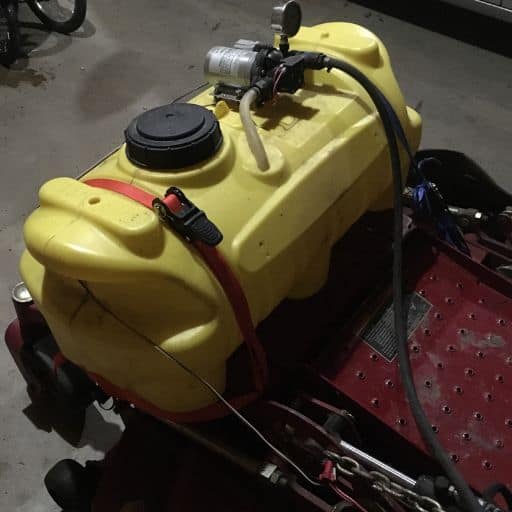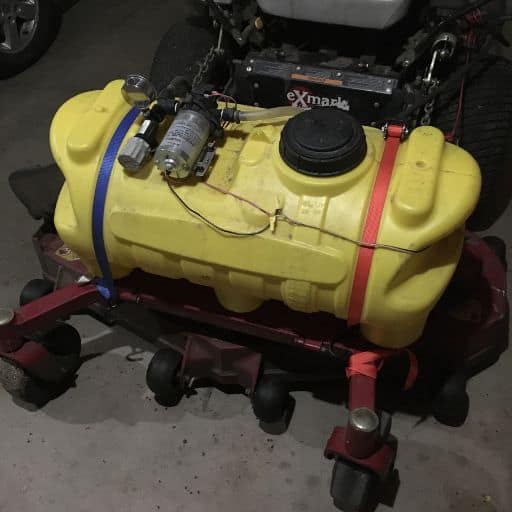Zero-turn mowers are one of the most popular types of lawnmowers. They provide so many advantages over a traditional lawn tractor but one of the things that can be a problem is mounting or pulling a sprayer.
If you have the land that requires a zero turn mower it’s likely that you also need a good size sprayer if you want to spray your yard. However, it can be difficult to mount the lawn sprayer or pull I’m on sprayer with a zero-turn mower. There is no clear location for a sprayer and there is typically no hitch for a pull-behind sprayer.
In this post, we are going to look at different methods that you can use to mount to report a sprayer with a zero-turn mower and also the size and weight limitations that you should know when using a zero-turn mower with your sprayer.
Mounting a Sprayer On a Zero-Turn Mower Deck
If you’re reading this there’s a good chance you own a zero-turn lawnmower and you want to mount a sprayer on it. It just makes sense. If you want to efficiently spray a large area you need a large sprayer you need a method to transport it. If you already own a zero-turn mower you want to see if it’s possible to use it to spray as well before investing in another lawn tractor or ATV.
One key thing to remember is that there are several different types of zero-turn mowers and there are also several different types of sprayers. The designs may be similar but the exact dimensions of different models of sprayers or zero-turn mowers will not be the same.
Mounting a Spot Sprayer on a Zero-Turn Mower
Spot sprayers may not have a boom but they are heavy and you need to mount them on something to move them around. Usually an ATV, UTV, or truck. A zero-turn mower presents an interesting challenge because, unlike the other types of vehicles, they do not have a dedicated box or rack to mount the sprayer.
I faced this particular problem myself. I have an Ex-mark mower and I wanted to be able to mount my 25-gallon spot sprayer on it for use around buildings and fences. I tried two different methods to mount my sprayer. The first route I chose seemed like a fairly obvious choice, mounting the sprayer on the mower deck.
I thought about building some sort of bracket or frame but in the end, it didn’t seem to add much support and I did not want to have to drill or make modifications to the mower deck. The 25-gallon sprayer tank dimensions happened to line up fairly well with my mower. From there I simply found areas on the mower deck to use ratchet straps to secure the sprayer in place.


This setup met my needs. I simply wanted to be able to easily transport the sprayer around my farm place. I could have stuck it in the back of my pickup, but then the sprayer controls would be harder to access and I would have to run the battery harness to the truck battery. The mower battery was easier to access.
Issues and Limitations of Mounting a Sprayer on a Zero-Turn Mower Deck
It’s nearly impossible to use a spot sprayer wand and spray effectively while driving a zero-turn mower. The hydro-static steering on a zero-turn mower does not allow for a “free hand” to operate the spray gun. In my case, 95% of the time I only sprayed when I was completely stopped.
The weight of the sprayer is another significant factor. Most mower decks are not designed to handle the full weight of a loaded sprayer tank. My sprayer holds up to 25 gallons of liquid. This means a full sprayer would weigh over 200 lbs. I typically only fill the sprayer half full when using it on my mower. Overloading the deck can lead to wear on your mower and unsafe operating conditions.
Attach Securely
Attaching a sprayer securely is crucial, but many zero-turn mowers lack appropriate locations for strapping down a sprayer. This can make it challenging to secure the tank properly, leading to potential safety hazards. I was able to get straps secured but this might not be the case with all lawn mower models.
Securing the tank is vital when mounting a sprayer on any piece of equipment, but this is especially true for a zero-turn mower deck. The wheels that support the deck can be small and on many models, they are not pneumatic. This means there can be a lot of vibration and bouncing applied to the sprayer on uneven or rough terrain. When towing or carrying a sprayer, it’s advisable to operate the mower at a slower speed to maintain control and ensure even spraying.
Mower Design & Capabilities
Zero-turn mowers are designed for maneuverability and not for extra space to carry equipment like sprayers. Therefore, mounting a sprayer can encroach on essential space, such as room for the operator’s feet, impacting comfort and safety.
Not all mowers and sprayers are compatible. Before proceeding with mounting a sprayer, it’s essential to check the dimensions and specifications of both the mower and the sprayer to ensure they can work together. This includes ensuring that the mower has the necessary towing capacity and that any modifications needed don’t exceed the mower’s capabilities.
The added weight of a sprayer that exceeds the manufacturer’s recommendations can strain the mower’s hydrostatic system, leading to overheating or even permanent damage. This also affects the stability and stopping time of the mower, creating safety issues. How much weight a mower can handle is a complicated topic but I break it down in this post on towing a sprayer with a zero-turn mower.
Use Caution
When using a wide boom sprayer with a zero-turn mower, it’s important to proceed with caution. The highly maneuverable nature of zero-turn mowers, while advantageous for navigating your lawn or field, can pose challenges when paired with a wide boom. This combination can cause the ends of the boom to move rapidly, increasing the risk of collision with obstacles or structures.
This is a contrast to the experience with pull-type sprayers, where the boom is generally more stable and less susceptible to sudden movements. It’s crucial to be aware of your surroundings and operate the sprayer at a controlled speed to minimize the risk of damage to the boom, the mower, or nearby objects.
DIY Sprayer Boom for Zero Turn Mower
For a larger yard with open space, a small boom sprayer is super useful assuming you have a lawn tractor-style mower to pull it. If you are like me and the many other folks who have a zero-turn mower you may be struggling to make a pull-type boom sprayer work. You don’t want to buy another mower, and you don’t want to use an ATV or truck that will tear up your yard. So what can you do?
Mounting a boom sprayer on a zero-turn mower has a few hurdles to overcome. Not only do you need to secure the sprayer tank but also the boom itself. This typically would require you to custom fabricate a bracket or supports for the boom in addition to the sprayer.
I wanted to mount a small boom on my zero-turn mower but I wanted to keep things as simple as possible. I assembled a lightweight boom across the back of the mower. I considered mounting it up front near the tank but did not want to have fluid blown into my face by a potential wind gust as I sprayed.
My mower has a muffler guard with slots in it. This provided me a spot to bolt on some brackets to mount my boom pipe. I used a ¾ inch square pipe and a TeeJet square pipe boom clamp that holds their brand of nozzle bodies.
The total width of my boom was 48 inches. This gave me the option to mount 2-3 spray nozzles. I typically use just two wide-angle Teejet Floodjet nozzles. This provides me with about 7-foot coverage at about a 24-inch boom height and about 30 percent overlap of the nozzles spray patterns.
If you would like to see the full parts list for this simple, easy-to-assemble sprayer boom, check out my article on building a DIY sprayer boom to see all the components.

Towing/Pulling a Boom Sprayer With a Zero-Turn Mower
A pull-type boom sprayer is a little more conventional way to use a boom sprayer on a lawn or large yard. However, most of our zero-turn mowers are not designed to accommodate traditional pull-type sprayer hitches. There are hitch add-ons that you can get. These are relatively inexpensive, but they are not universal. For example, my sprayer did not have a good place to add a hitch.
There are several reasons as to why there is typically not a hitch on a zero-turn mower. The primary reason is not that these machines can’t tow, it is that they are not designed for it. Zero-turn mowers lack braking systems that are required for safely stopping with an extra load. The additional weight can also provide stress on the transmission.
Again, these things do not mean that a zero-turn mower necessarily lacks the power or ability to handle small loads assuming you are cautious. Remembering that all mowers are different and their ability to tow will vary. If you are interested in towing capacities and other factors that may limit a zero-turn mower’s ability to tow a sprayer, read this post on towing a sprayer with a zero-turn mower.
I did attempt to make a simple hitch for my mower without drilling or cutting holes in the frame. I used the same brackets that I installed for my mounted spray boom and simply added a couple of quick links to connect the drawbar of the sprayer trailer.
This worked, however, I did not see it as a suitable long-term solution, and mounting the sprayer and boom on the machine itself was much more manageable.
Conclusion
Zero-turn mowers are extremely effective at the job they are designed for mowing. However, they are an investment, and if you can figure out a way to use them to help spray your yard more effectively that is a bonus.
There are ways to mount or tow a sprayer with a zero-turn mower but remember all mowers and sprayers may be different. The key is making the necessary and safe modifications to fit your sprayer to your mower.

